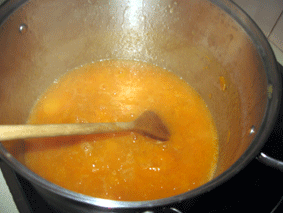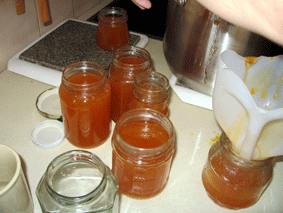
The apricot season runs from December to February, so it is officially over now, but if you are lucky, you can get some end-of-season bounty and turn it into jam so you can have that apricot taste in the middle of winter.
While I love making jam, I do not always want all of that added sugar. With 1.7 million diabetics in Australia (Diabetes Australia), we probably can all agree that the amount of sugar added to make a traditional jam is not a good idea. That is why I wrote my book, Sugar-Free Home Preserving, which is now available in stores.
This recipe makes five 250 ml jars. You get to choose the sweetener you wish to use. You can use sugar if you want to, but use way less, or choose an alternative sweetener. The key is that you have to use Low Methylester Pectin, which is different from regular pectin, and the one you must have to make sugar-free or low-sugar jams. It does not need sugar to set as regular pectin does. It needs calcium, which comes in the packet.
Ingredients:
- One kg of apricots with their stones removed
- ¼
cup water - 300 to 400 grams of xylitol or sugar
- Two teaspoons Low Methylester Pectin
- Two teaspoons of calcium water (see the pectin instructions or this video)
- Two to three tablespoons of lemon juice (the riper the fruit, the more you use)
Instructions:
- Prepare your 250 ml jars and lids by sterilising them in boiling water for ten minutes.
- The sterilisation step can be skipped, and you can use washed, rinsed, hot jars if you are processing for 10 minutes or more in the boiling water bath at the end of the recipe.
- Wash your apricots, remove the stones, and finely chop them. Place them into your preserving pan with ¼ cup of water and cook for five minutes to soften the fruit.
- Use a potato masher to crush the fruit, releasing some juice and natural pectin.

- In the meantime, mix your Low Methylester Pectin with 100 grams of your xylitol or sugar.
- Slowly add your xylitol/pectin or sugar/pectin mixture, stirring constantly to ensure that it is evenly distributed throughout your fruit mixture.
- Add your lemon juice, calcium water, and the remaining xylitol or sugar and mix in well.
- Using high heat and stirring occasionally, bring your jam mixture to a full rolling boil and boil for one to two minutes. Remove from heat.
- Place your jam into your hot, 250 ml jars using a ladle and jar funnel, leaving a one-and-a-half centimetre headspace. Clean the rims of the jar to ensure you get a good clean seal and cap with your new lids.

- Process your filled jars in a boiling water bath for five minutes.
- Alternatively, if you did not sterilise your jars and lids, process them in a boiling water bath for 10 minutes.
If you are unfamiliar with the boiling water bath, look here: Boiling Water Bath.
https://www.greenlivingaustralia.com.au/home-preserving/basic-principles/high-acid-boiling-water-bath/
So if you follow the above, you have accomplished a few things:
- You have saved money
- You have made a health jam
- You have reused jars and helped the planet
- You have taken a small step to reduce the epidemic of diabetes in Australia
- You have rebelled against the system by making your own.
I hope that you enjoy this recipe. Apricot is one of my favourite fruits, and I hope to get fruit from my tree for the first time next year. While I will be eating lots of fresh apricots, I will set some aside to make jam so I can have a bit of summer in July.
As always, live well.
Valerie